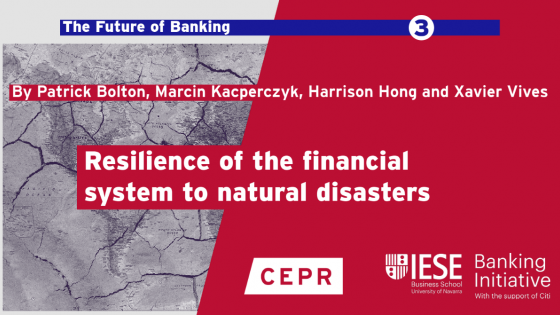The Covid-19 crisis and the subsequent downturn have reinforced the need to evaluate and address highly disruptive environment-related events as well as the strategic importance of sustainable finance in the upcoming years. The pandemic may serve as an experimental study to learn about climate change mitigation policies. Similar to the coronavirus outbreak, climate change involves the realisation of tail-related events manifested as global externalities that pose systemic financial risk, involve market failures, and call for supportive public intervention and international coordination.
The Covid-19 crisis and the subsequent downturn have reinforced the need to evaluate and address highly disruptive environment-related events as well as the strategic importance of sustainable finance in the upcoming years. The pandemic may serve as an experimental study to learn about climate change mitigation policies. Similar to the coronavirus outbreak, climate change involves the realisation of tail-related events manifested as global externalities that pose systemic financial risk, involve market failures, and call for supportive public intervention and international coordination.
Several questions arise: What are the risks associated with climate change and which risk-management tools are appropriate to address them? What is the role of central banks and asset managers in the transition to a green economy? How do the systemic nature of natural disasters and the potential persistence of climate shocks affect diversification and hedging strategies of financial intermediaries? What commitments in sustainable finance mandates are needed to meet ‘net-zero’ emissions targets?
Natural disasters are a major source of systemic risk, and finance must play a major role in the prevention and taming of those risks. Financial institutions are expected to integrate environment-related risks explicitly into their risk appetite frameworks, and improve their reporting of climate-related and natural exposures. They are expected to determine a forward-looking business strategy in which climate risk factors are monitored on a continuous basis and incorporated into credit risk management (ECB 2020). Banks and other financial intermediaries must be part of the solution to the climate change threat.
The post-crisis regulatory reform agenda analysed in the first report in the Future of Banking series (Bolton et al. 2019) has in many respects proved effective in building a more resilient financial system. But is this system equipped to withstand natural disasters of increasing intensity and frequency as a result of climate change? Natural disasters are likely to have a growing impact on banks’ balance sheets. As described in the second report in the series (Carletti et al. 2020), the Covid-19 crisis has challenged the traditional bank business model, accelerating digitalisation and extending the persistence of low interest rates.
Download Resilience of the Financial System to Natural Disasters here.
The third report in the series (Bolton et al. 2021) argues that fighting natural disasters such as climate change requires acombination of public interventions and private sector mitigation strategies to reduce the long-term implications of climate-related events.
Three main messages derive from the report:
- To fulfil their financial stability mandate, central banks should play a proactive role in promoting mitigation and coordinating climate risk policies consistent with government mandates, the private sector and civil society. But the policy response to stabilise the financial system should avoid an excessive reliance on central bank backstops to limit moral hazard.
- Asset managers can facilitate the management of climate risk and promote green financing. Financial markets and asset managers can discipline market participants to stimulate mitigation efforts by the private sector. Shareholder activism has proved helpful in forcing disclosure of climate-related information, but mandatory disclosure policies may be necessary if greater disclosure is desired.
- Investments in climate mitigation could be as important for climate risk-management responses as vaccine development has turned out to be for the Covid-19 pandemic. Due to the presence of externalities, a tax on capital to fund mitigation is needed to implement the pathways to net zero. Sustainable finance mandates can be a substitute for such a tax, but they have to be significantly more stringent than what is observed in practice.
Natural disasters, climate change and central banks
Natural disaster and climate shocks pose a fundamental question for the lender of last resort (LOLR) as a policy response to dampen the financial and economic repercussions from such events. Natural disasters can severely affect economic activity and quickly destabilise financial markets. But the policy response to stabilise the financial system should avoid an excessive reliance on the central bank backstop. Since the expectation of a bailout incites moral hazard in lending and risk-taking, LOLR interventions should not become the default intervention to stem a financial crisis.
Central banks have been called on to contribute to fight climate change (e.g. Bolton et al. 2020, Brunnermeier and Landau 2020). A first prerequisite to manage climate change risk is the measurement and reporting of carbon emissions by companies and financial institutions. In line with the net-zero commitments, corporations should be required to report their emissions on an annual basis as well as future projected emissions up to a three-year horizon. Forward-looking scenario analysis allows for a flexible approach to climate risk management that at the same time cuts through the complexity of making reliable probability assessments.
Another important tool for the transition path towards a carbon-neutral economy is the implementation of climate stress tests to identify not only the size of climate risk exposures in the banking and insurance sectors, but also the impact of the feedback effects from climate shocks. Yet the standardised reporting of physical climate risk exposures is technically challenging and may not be immediately feasible. A priority for the coming years should be to systematise carbon disclosures and to extend disclosure mandates to as many countries as possible.
A more difficult and controversial question is whether climate change risk considerations should also touch on the conduct of monetary policy and the management of central bank reserves. When it comes to collateral frameworks and reserve asset management, central banks need to align their policies with the broader net-zero commitments of their countries.
Asset managers’ response to natural disasters
Although an array of hedging instruments has been developed by the financial industry, natural disasters involve systemic risks that investors cannot fully hedge. This is even though new methodologies have been designed to improve climate risk hedging (Engle et al. 2020). While large investors (such as universal owners, see Azar et al. 2020) are aware of the danger posed by climate-related systemic risk, there is a financial innovation role for financial institutions to issue instruments with more complete state contingencies that deal with the full spectrum of natural disasters and long-term climate-related risks.
Asset managers can complement political action against climate change through corporate activism. One specific instance where activism proved particularly helpful is in pushing for disclosure of climate-related information. Environmental shareholder activism increases the voluntary disclosure of climate change risks, especially if initiated by institutional investors, and even more so if initiated by long-term investors.
Mitigating disaster risks to the financial system
The successful experience of vaccine development to fight Covid-19 can be used to draw lessons for the importance of a portfolio of mitigation measures to increase the resilience of the financial system to natural disaster shocks. An analogy that can be drawn with public–private partnerships that can scale up investment in green infrastructures and technologies for carbon capture and storage. Costly adaptation, such as net-zero corporate emission targets by means of abatement technologies, coastal green infrastructure, and protection of biodiversity, is needed to reduce aggregate risks and improve social welfare.
Vaccine development for Covid-19 is not equivalent to greenhouse gas emissions control through carbon taxes. The reason is that measures to mitigate the effects of climate change such as seawalls to protect against sea level rising risk do not have a direct impact on firms’ earnings in contrast to Covid-19 mitigation activities that protect workers.
As many decarbonisation measures reduce aggregate risks to the financial system but do not affect firm earnings, a tax on capital might be needed to fund efficient mitigation due to the presence of externalities. Sustainable finance mandates that restrict capital market investments to firms that meet mitigation spending thresholds can be a substitute for such a tax, but they have to be significantly more stringent than what is observed in practice to achieve an efficient outcome.
References
Azar, J, M Duro, I Kadach, and G Ormazabal (2020), “The Big Three and Corporate Carbon Emissions Around the World”, ECGI Finance Working Paper 715, Journal of Financial Economics, forthcoming.
Bolton, P, S Cecchetti, J P Danthine and X Vives (2019), Sound at Last? Assessing a Decade of Financial Regulation, The Future of Banking 1, CEPR Press (see also the Vox column here).
Bolton, P, M Despres, L Pereira da Silva, F Samama and R Svartzman (2020a) “The green swan: Central banking and financial stability in the age of climate change,” Bank of International Settlements and Banque de France
Bolton, P, H Hong, M Kacperczyk and X. Vives (2021), Resilience of the Financial System to Natural Disasters, The Future of Banking 3, CEPR Press.
Brunnermeier, M and J P Landau (2020), “Central banks and climate change”, VoxEU.org, 15 January.
Carletti, E, S Claessens, A Fatas and X Vives (2020), The Bank Business Model in the post-Covid-19 World, The Future of Banking 2, CEPR Press (see also the Vox column here).
ECB (2020), Guide on climate-related and environmental risks. Supervisory expectations relating to risk management and disclosure.
Engle, R, S Giglio, B Kelly, H Lee and J Stroebel (2019), “Hedging climate change news”, VoxEU.org, 31 July.






